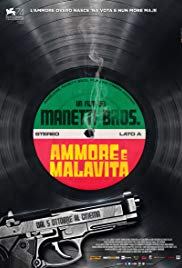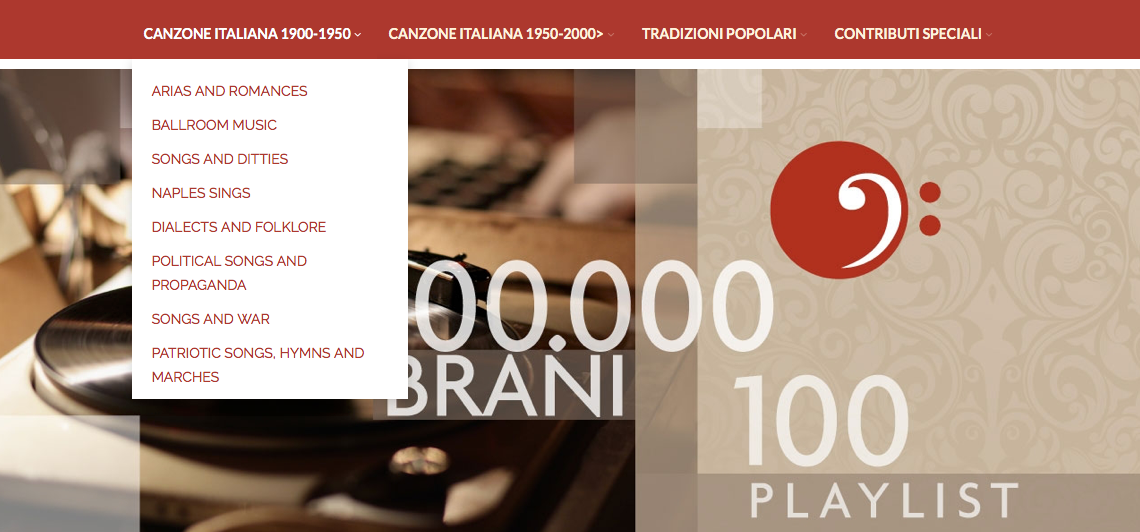A Mafia Movie Musical
Surprisingly, a Mafia musical and made its debut as it opened the 12th annual San Diego Italian Film Festival…
A Mafia Movie Musical
America has a long running tradition of movie musicals. With masterpieces such as “Singin’ in the Rain” to modern box office hits like “La La Land,” the genre has been cemented as an undeniable force in American film history. However, a new Italian take on the genre is causing quite a stir in the film community. "Ammore e Malavita" or “Love & Bullets” is described as a Mafia musical and made its debut as it opened the 12th annual San Diego Italian Film Festival.
Antonio Iannotta, the artistic director of the festival, has stated that the more accurate description for this crime film would be ‘a Camorra musical,’ since the film is set in Naples and the crime in that part of southern Italy goes by that name. "Ammore e Malavita" won the Donatello Award (the Italian equivalent of the Oscar) for Best Film earlier this year and is the festival choice.
Although Italy is the birthplace of opera, musicals are not really a part of its cinema. Iannotta said that Italian cinema doesn't have a tradition of musicals to draw on, but that the filmmakers, Antonio and Marco Manetti, come from outside the film industry and with a background making music videos.
We hope you’ve enjoyed learning about A Mafia Movie Musical! Want to get rid of those pesky subtitles while enjoying your favorite foreign films? Our native instructors and culturally immersive group classes are sure to have you singing along seamlessly at your next viewing! Click below to learn more.
Monopolizing Music
Italian song rights collecting organization, SIAE has been ordered to seek out and resolve monopoly-related issues by Italy’s Competition Authority to end market distortion tactics…
Monopolizing Music
Italian song rights collecting organization, SIAE has been ordered to seek out and resolve monopoly-related issues by Italy’s Competition Authority to end market distortion tactics.
Collective licensing (where music rights owners license as one through a collecting society) always raises monopoly concerns. How those monopoly concerns are dealt with by copyright or competition law varies hugely from country to country. In the U.S., the 2 largest rights holders: BMI and ASCAP are regulated, while in the UK collective licensing is subject to the intervention of the copyright tribunal. In most European countries, however, regulation of licensing has traditionally been much less formal and severe.
The European Union has sought to make the European collecting societies more competitive, both in terms of recruiting members and licensing rights. Responding to those moves within the EU, Italy changed its laws last year to encourage more competition in the licensing market. This has created a dispute between SIAE and two newer licensing organizations called Soundreef and Innovaetica.
SIAE is charged with having used tactics to prohibit songwriters to choose additional organizations to represent them. Because of this, the ICA has demanded that the SIAE not only immediately comply but also pay a fine of 1000 euros.
SIAE has responded by stating that it would evaluate the Competition Authority’s order until they are confident that the organization was compliant with the laws in place despite the regulator’s demands.
We hope you’ve enjoyed learning about how the Italian Competition Authority is keeping SIAE from Monopolizing Music! Do you think this course of action will help aid Italian musicians in finding a royalty collector that works for them? Join the conversation below!
The World's Newest (Oldest) Guitar
Italian musician and designer Lorenzo Palmeri has designed the oldest guitar in the world…
The World's Newest (Oldest) Guitar
Italian musician and designer Lorenzo Palmeri has designed the "oldest guitar in the world.” It's made of ancient Kauri, a 50,000-year-old wood native to New Zealand.
Photo: Lorenzo Palmeri
The navel comes in three different designs. To create the limited edition guitar from Kauri wood, Palmeri collaborated with furniture maker and wood specialists, Riva1920, who helped him work with the 50,000 year old material.
Kauri wood comes from prehistoric Kauri trees which were buried and preserved in New Zealand’s North Island. Buried by a yet to be explained natural occurrence, the trees have survived for centuries underground which has preserved the timber in perfect condition.
All 3 guitars' designs are meant to contrast masculinity and femininity characterized by the round, 'feminine' form and 'masculine’ angularity. The guitars' designs are "meant to match its tones, which are capable of extending from very sweet to very powerful" says Palmeri.
Photo: Lorenzo Palmeri
The Kauri wood guitar is one of three new guitar models from Palmeri. Another of the models is made of Fenix NTM, a nanotech material featuring low-light reflectivity and an anti-fingerprint, soft-touch effect, and the final model is a classic guitar that is made from beech wood.
We hope you've enjoyed learning about The World's Newest (Oldest) Guitar! Want to learn more about all that is happening in Italian music? Click below to check out more articles from our Italian Culture Blog!
Musical Notation en Italiano
However, the rules for music notation were transcribed for the first time in Italian around 1000 AD…
Musical Notation en Italiano
Anyone that has experienced the world of music can attest to the first time they opened a piece of music only to be guided by foreign terms. This is because when the rules for music notation were worked out and transcribed, it was all done in Italian around 1000 AD. In fact, Guido of Arezzo created the earliest version of the "heads-and-stems-on-staves" structure that we use today.
Over the next few hundred years, musicians built on Guido’s system and theorists added useful features like note values, time signatures, and of course musical directions. After some time these terms became quite fashionable, so when the rest of Europe started notating music, Italian was the only logical choice. Below are a few of the most common words one may come across in a piece of music.
Because Italian is naturally a musical language, it comes as no surprise that it’s universally used for musical directions. While there are some Italian terms like ‘tempo’, ‘adagio’, ‘allegretto’ and ‘rallentando’ which are only used in the context of writing or reading music, some words such as ‘concerto’, ‘piano’, ‘soprano’ and ‘opera’ became so stylish that they eventually made their way into our everyday English musical vocabulary.
We hope you've enjoyed learning about Musical Notation en Italiano! Looking to gain a better understanding into the cultural significance Italy has played in shaping the world of music linguistically? Our culturally immersive group classes taught by native instructors can help you read any foreign notation with ease! Click below for more info!
"KeepOn" Making Music
Two times every year, KeepOn hosts meetings that bring together musicians, bands and their fans to solve problems caused by changes in society and aims to spread high-quality Italian music…
KeepOn Making Music
A new association for Italian music venues, festivals, and promoters, KeepOn Live, has launched in Milan fronted by Marco Manzella , the founder of KeepOn. The organization was created in 2004 as a ‘cultural association’ for club-sized venues.
Manzella has stated that “After almost 14 years of networking activity, and the promotion and distribution of original Italian live music throughout the whole nation, venues, and festivals have [asked us] to create a sector association.” The association, he adds, is “independent, apolitical, nonpartisan and nondenominational”, and brings together “venues and [organizations] that organize live music”.
Two times every year, KeepOn hosts meetings that bring together musicians, bands and their fans to solve problems caused by changes in society and aims to spread high-quality Italian music. The organization has created “100% Best Live”, a ranking system voted by the artistic directors to select the best bands in their local area along with joint advertising and enter sponsorship agreements to support the economies and promote the music venues of the association.
Federico Rasetti, CEO, and vice-president of KeepOn Live has stated: “It will be a really representative association, which will group exclusively live musical professionals and develop around their directives, demands, and needs. It will be inclusive and qualifying, also welcoming those small companies that wish to grow in this sector, helping them to develop and strengthen.”
We hope you've enjoyed learning about how KeepOn is working to make sure Italians KeepOn Making Music! Would you be interested in seeing something like this in the United States? Join the conversation below!
A Century of Musica
Italy's Ministry of Culture has just put an entire century of Italian popular music online, for FREE!
Italy's Ministry of Culture has just put an entire century of Italian popular music online, for FREE!
canzoneitaliana.it contains just over 200,000 tracks available to stream unlimited thanks to of Italy's Central Institute for Sound and Audiovisual Heritage, ICBSA in partnership with Spotify and has been launched to coincide with Italy's biggest music festival, Sanremo.
The vast catalogue ranges from 1900 to 2000 and is divided chronologically, geographically and thematically. It includes traditional songs from each of Italy's regions, political songs from the first half of the 20th century, and Italian hits used on movie soundtracks.
Not positive what to look for? The service contains specially curated playlists for an overview of everything from Enrico Caruso's greatest hits to the women of Italian rock to cult TV theme songs. Even better, each section is accompanied by historical and musical context and is available in 8 languages.
If, somehow, you still can't find what you're looking for, an additional 5,000 songs will be added each month, according to Culture Minister Dario Franceschini who wishes to create ”a sort of central state archive that will last throughout time".
We hope you've enjoyed learning about "A Century of Musica!" Interested in exploring the site in it's native language? Check out our fully immersive, culturally infused lessons to get on the road to fluency today!

















